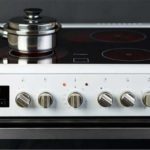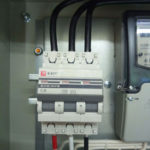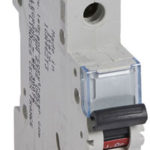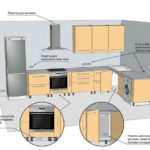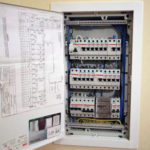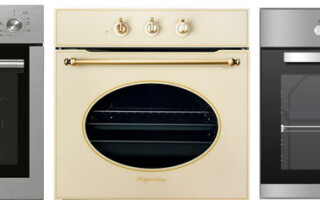When making repairs in the kitchen, the question very often arises: how exactly to connect the cooktop and oven so that it is safe and does not require a lot of effort and money? Manufacturers and sellers of electrical appliances always recommend entrusting the connection to professionals, but most often this service is expensive or is an additional option imposed by the seller to the buyer.
As practice shows, the issue of connecting the oven and cooktop can be solved independently even by a person who has never been associated with electricity, but who has a desire to understand it and at least a minimal set of tools.
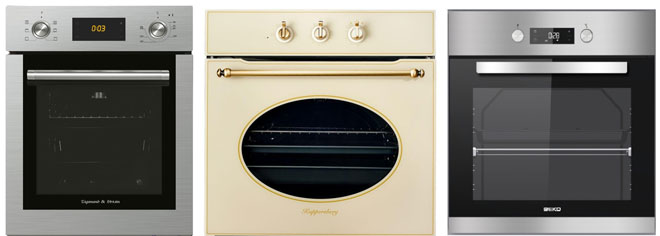
Next we will figure out this difficult matter: how to connect the hob and the oven after all?
Contents
How much power an electric oven and hob has
The first and most important thing you need to know in order to perform these works properly Is the rating of the appliances you want to connect.
The power of an electric oven and cooktop is related to the chosen mode of operation of the device and the number of burners involved. But to calculate the electrical wiring diagram and the subsequent safe operation, we need to know only the maximum power of the oven and cooktop, which is measured in watts (watts) or kilowatts (kW).
The maximum power of electrical appliances is always indicated on the appliance itself, on its packaging and in the operating instructions. For an oven, depending on its type, model and optional features, the maximum power rating ranges from 2.5 kW to 4 kW, for the hob this value can take 6 kW to 9 kW.

Calculation of consumables parameters
Once we have sorted out the capacity of the oven and cooktop, it is necessary to assess the state of the electrical wiring in your apartment (or house) and, on the basis of these data, make a connection diagram and calculate the parameters and consumption of materials.
Connecting the oven and stove hob can be of two types: separate and joint. Separate connection means that for each device from electrical panel Is laid a separate cable with the necessary cross section, which is made at the stage of overhaul or construction. This method is time-consuming and not possible in the presence of finishing, but it is the best and safest.
Joint connection is used when there is only one line of cable for connecting powerful appliances and in the conditions of already finished finishing.
Selecting the type and diameter of cable cross section based on the power of appliances
When choosing the first type of connection we have two options: both lines are already there or there is a need to pull an electrical cable from the switchboard. But in either of these cases it is necessary to calculate the cross-section of the power cable, compare it to what is available or choose the necessary cross-section and type for its laying.
For proper cable choice it is necessary to know an important point: for electrical wiring in residential areas according to the PUE should be used three-core cable made of copper, covered with non-flammable insulation. Aluminum wires in the electrical wiring of the apartment or house - a relic of the Soviet past and is not used now because of the presence of significant disadvantages compared to copper.
According to the standards for laying In the apartment use the following types of cable:
- For power lines from the switchboard to energize powerful electrical appliances (cooker hobs) is used VVG-3 section 6 mm2 (VVG 3x6);
- For installation of the main wiring lines and supply lines to the sockets (ovens) VVG-3 with 2,5 mm2 cross-section (VVG 3х2.5) or 4 mm2core (VVG 3x4);
NYM electric cable of corresponding characteristics can also be used.
The choice of the final cross-section for the cable is calculated on the total maximum power of the electrical appliances to be connected to the line and is based on the fact that the cross-section of the wiring must be able to withstand the rated load limited by the circuit breaker in the distribution board.
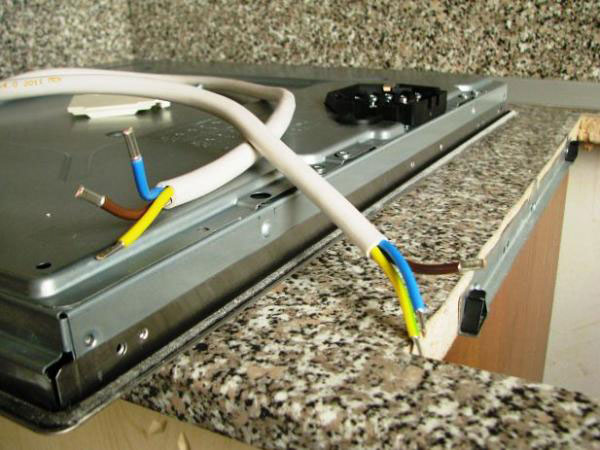
What should be the ratings of the circuit breaker and RCD
Now let's move on to Choosing a circuit breaker and decide whether or not you need to use a circuit breaker (RCD) on the hob or oven line.
According to the regulations, in order to choose the right circuit breaker, you must be guided by the following data:
| Cross section of copper conductors | Current carrying capacity | Maximum rating for a single-phase 220 V circuit | Rated current of the automatic breaker | Approximate rating |
|---|---|---|---|---|
| 1.5 sq.mm | 19 А | 4.1 kW | 10 А | Lighting and signaling |
| 2,5 kV | 27 А | 5.9 kW | 16 А | Socket groups and floor heating |
| 4.0 sq.mm | 38 А | 8.3 kW | 25 А | Air conditioners, water heaters, standard ovens |
| 6.0 kV | 46 А | 10,1 kW | 32 А | Hobs, electric stoves, heavy duty ovens |
From this table, we can choose the cross section of the electric cable and the circuit breaker for each line to connect the hob and the oven. So, for an oven with a power of 3.5 kW you have to use a cable with a cross section of 2.5 mm2 and a circuit breaker rated at 16 A. For a hob with a power rating of 8.5 kW we will use a 6 mm cable2 and a circuit breaker rated at 32 A.
The next question that often arises when connecting kitchen appliances: is it necessary to install circuit breaker (RCD) along with a circuit breaker?
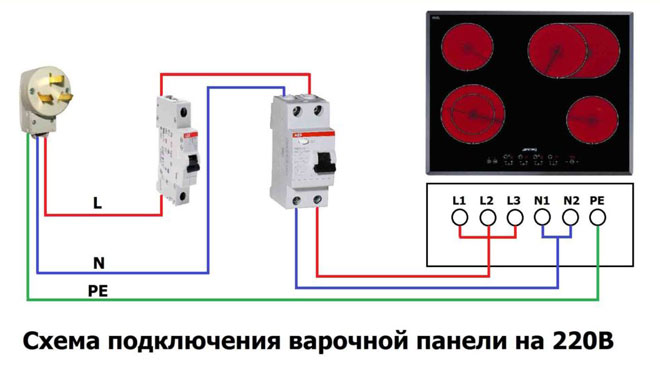
The circuit breaker protects the line against short circuits and overloading, and therefore against overheating of the wiring. RCD is necessary to disconnect the power supply in case of current leakage to the housing of the connected devices and to prevent electric shock to humans.
The need to install RCDs for kitchen appliances is not regulated, but it is recommended. It often happens that after several years of active use of the appliance, some internal electrical cable may be frayed or damaged and there may be a "breakdown" in the case of the device. In rooms with high humidity or if water is spilled on the appliance, current leakage can also occur. Touching such an appliance may result in an electric shock, the consequences of which can be very unfortunate. With a RCD, the power to this line will shut off before a person is electrocuted, and prevent unpleasant consequences.
Selecting the rating of a residual current device is not difficult: the rated current should be higher than that of the circuit breaker. For example, If the circuit breaker is 16 A, then you should choose a RCD with a rating of 25 A.. Also RCDs are selected on the basis of leakage current: for dedicated lines most often use devices with a trip threshold of 10mA.
Note! RCD rating is the value of the maximum switching current of the contacts, at which the RCD will maintain its performance.
With advances in technology on the market appeared devices that combine the circuit breaker and RCD. This device is called a differential circuit breaker. The advantage of this device is compact in the electrical panel and no problem matching RCD to the circuit breaker. The undoubted disadvantage will be the price: slightly higher than the set RCD + circuit breaker.
Connection options: direct, socket and plug or terminal block in the junction box
There are several ways to connect the oven and cooktop to the electrical grid:
- Directly to the line that comes from the electrical box;
- Using a power cord:
- to a socket with the required power;
- to a fuse box installed next to it in a special switchboard;
- to a terminal strip mounted in a junction box near the appliance.
Direct connection of the oven and cooktop is possible with a sufficient length of electrical cable from the wall to the device. There is nothing difficult in such a connection, because the information is always specified in the instruction manual of the appliance. Each appliance must be connected to its own line according to the instruction manual.
What kind of socket and plug is needed
An outlet with a plug is the most common way to connect all electrical appliances, including the oven and cooktop. Household outlets come in 16A and 32A ratings. The choice of outlets, as well as the choice of cable with fuse boxes, depends on the power of the device to be connected. When connecting such high-powered electrical appliances as stoves, it is necessary to use outlets rated only 32A. For the oven, the following socket is suitable 16А. It is best to choose a well-known manufacturer: ABB, Legrand, Schneider Electric, etc. It is not recommended to install a socket on a line that simultaneously connects the hob and the oven. It is preferable in this case to use an automatic circuit breaker.
A heavy-duty line is connected to the fuse boxes installed nearby in a special box and is designed for the use of several appliances.
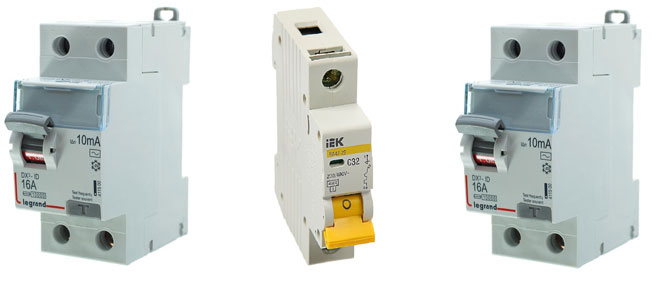
In this case, a heavy-duty line (e.g. 6mm²²) is fed into a special box, protective circuit breakers for each appliance are installed (+ RCD, if installation with this device is selected) and the corresponding devices are connected to the fuse. The main rule that must be remembered during this connection: the rating of the circuit breaker protecting the power line and the electric cable must be higher or equal to the sum of ratings of the circuit breakers connected to this cable. For example, if in the main switchboard, this line of 6 mm² is protected by a circuit breaker rated 32А, then in a special box near the devices to be connected there should be no more than 2 circuit breakers of 16А.
Terminal block selection
To the terminal block mounted in the junction box next to the devices connected by analogy with the socket. The difference between this method and the socket is that the connection is more reliable and permanent. When connecting in this way, it is necessary that the electrical cable that goes to the terminal block corresponds to the power of the devices connected to it. As with all accessories, the terminal blocks should be selected according to the wattage of the devices and their rated current.
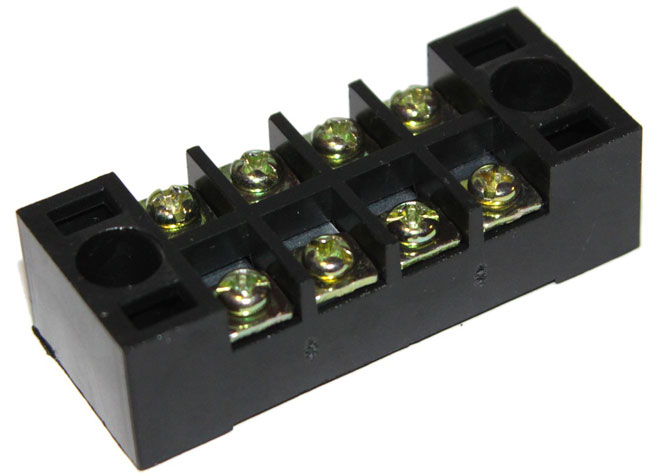
Warning. The 16 amp terminal blocks are not suitable for hobs, buy 32 amp terminal blocks.
If the lines to the oven and the hob are separate, it is advisable to use a direct connection, using sockets or terminal strips. Fixtures are connected to a single power line, when there is no possibility of laying an additional line in the presence of finishing.
Choosing a location for the outlet
If you choose to connect the oven and cooktop to the socket, an important question arises: where exactly to place it? Naturally, it is not aesthetically pleasing to place the socket above the worktop, so you need to find a concealed location with good access to turn on/off the appliance.
Manufacturers of devices recommend not to place sockets behind plugged-in appliances. The best location would be the bottom of the wall at the level of the base of the kitchen unit under the appliance or on the wall with access from a neighboring cabinet.
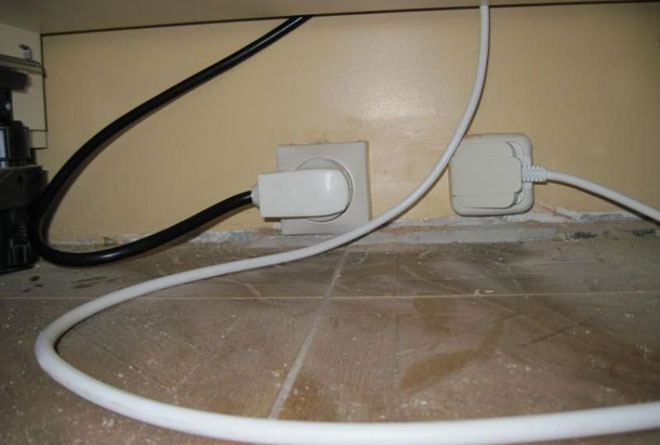
Performing the installation work
The most important thing when performing electrical installation work is to observe safety rules. Always work only with the power off.
Connecting the plug and socket
To connect the plug wire from the oven or stove stripped, if multicore wire, then crimp it lugs NSHV and pass through the body of the plug. Phase and zero are mounted on the outermost pins of the plug. The yellow-green grounding wire - on the middle contact. To prevent the wire from dangling inside the plug, clamp it with a clamp and screw the plug body.
Connection of the socket is as follows: the socket is mounted in the required place, the body of the socket is removed and the power line is connected to it. Phase and zero are mounted on the outermost contacts of the socket. The yellow-green grounding wire - on the middle contact. Next, screw on the socket body.
Wiring Diagrams for Wiring the Oven and Cooktop
There are two basic wiring diagrams Electric hob There are two basic wiring diagrams for connecting an oven or cooktop: single-phase and three-phase. The connection is made to the terminals, the cooking surface, which can be accessed through its back cover - it is unscrewed and removed. Pay attention to the color markings on the terminals - this will allow you not to make a mistake, read the instructions for connection and safety requirements.
Single-phase 220V circuit (most common in apartments)
The L phase is simultaneously connected to terminals L1-3 of the cooktop. For this purpose, two removable copper jumpers are factory-installed between them. If for some reason you do not have jumpers, you can make them yourself from electrical cable, which cross section is not less than that of the supplying cable. The neutral N is connected to terminals N1-2. The protective conductor PE is connected to the PE terminal.
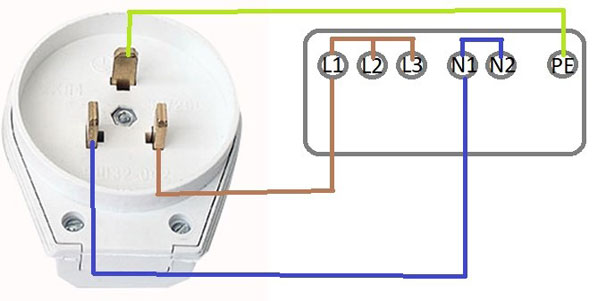
Three-phase 380 V circuit (typical for private houses and companies)
Phase A, B, C - Connect to terminals L1-3 on the cooker hob. In this case, remove the factory installed jumpers between terminals L1-3. Zero N is connected to terminals N1-2. The PE protective conductor is connected to the PE terminal.
Connecting an oven is much easier. Most of the time, an electrical cord with a plug is supplied with these appliances, so the euro plug is simply plugged into the euro socket. It is best to use a separate cable to connect to the fuses or terminals, because if you cut the plug from the cable supplied, it can significantly affect the warranty of this appliance.
The wiring diagram of the oven is always single-phase:
- The L phase is connected to the L terminal of the oven;
- The neutral N is connected to the N terminal;
- The protective earth conductor PE is connected to the PE terminal.
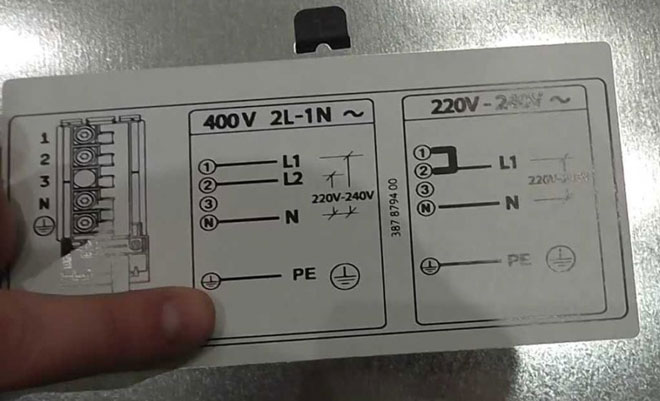
Common Mistakes
The most common mistakes made when connecting the cooktop and oven are:
- Improper selection of the cable cross-section. As mentioned above, the cross-section of the electric cable is chosen based on the combined maximum power of the devices to be connected.
- It happens that when connected to a single-phase network, some of the burners on the appliance do not work. This can be due to the lack of bridges between the phases when connecting the power cord.
- The wrong location of the socket is also very common: After installation, it is impossible to reach the plug and unplug the device from the mains.
Here we have understood all the nuances of connecting the hob and oven. Remember that the health and life of all family members, as well as the serviceability and durability of electrical appliances depends on how properly connected electrical equipment.
Related Articles:

